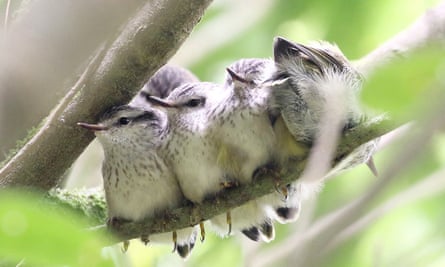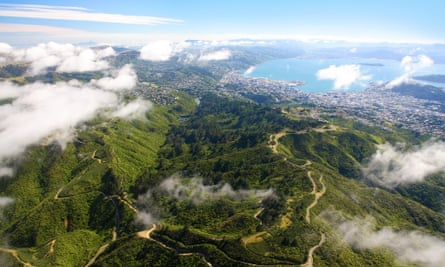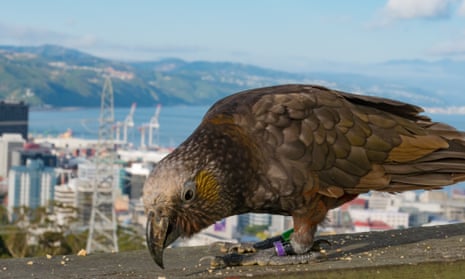During the height of the Delta outbreak last year, Wellington awoke to some exciting news – a pair of titipounamu, New Zealand’s smallest bird, which had been missing from the city for more than 100 years, had built a tiny nest in a patch of urban forest just a few kilometres from parliament.
It was a huge point of pride for Wellingtonians and has been credited to the creation of urban eco-sanctuary Zealandia. Opened in 1999, the sanctuary can lay claim to having boosted urban bird populations and fostered a sense of city-wide unity over conservation.
“In the 1990s seeing a tūī in suburban Wellington was a big deal, let alone a kākā,” says Adam Ellis, a keen birdwatcher in Wellington. “Zealandia … created such a change in bird life that birds like tūī became a common garden bird.”
For Mike Taylor, another bird lover, seeing the native falcon, the kārearea, sitting in his pine trees overlooking the valley “symbolises the massive increase in avian activity in the last two decades”.

But the charismatic parrot the kākā is “the biggest success story of Wellington”, he says, hastening to add: “Being woken up by their raucous call of 5am gangs patrolling the Kaiwharawhara stream corridor is perhaps no longer seen as a success by some!”
New research published in the Journal of Animal Ecology found that restoring native forest in cities does indeed bring back native birds – even those absent for generations – and the older the forest, the more species it can support.
Its lead author, Elizabeth Elliot Noe, a doctoral student at Lincoln University but based in Waikato, studied 25 restored urban forests across Hamilton and New Plymouth, representing 72 years of forest development.
She found that younger forests supported small insect-eating and omnivorous birds like the curious pīwakawaka, while older forests attracted back nectar- and fruit-feeding species like the melodious tūī.
As well as restoring balance to urban ecosystems, the return of birdlife creates an emotional bond between humans and other species, Elliot Noe suggests.
“We’re becoming disconnected from our natural environments and the native species that make up those environments … There’s a lot of research that shows that … having daily experience of [nature] is good for our mental health, wellbeing and physical health,” she said.
A halo effect for the whole city
Wellington is the poster-city for that growing connection between people, birds and conservation. A city-wide predator-free campaign has residents setting pest-traps in their backyards and planting native trees, and local conservation groups hold regular working bees, while Zealandia boasts 500 volunteers and a long waitlist to join. Walking through Zealandia, it isn’t difficult to see why.
Most visitors compare it to Jurassic Park, says Gini Letham, its lead ranger. The 225 hectares of regenerating bush just 10 minutes from the city centre surrounds a lake, winding creeks and a wetland, and is home to a cacophony of birdsong from 40 different species.
Nearly 9km of predator-proofing fence surrounds the block. The eco-sanctuary hosts more than just birdlife: tuatara, tuna (native eels), freshwater mussels, frogs and wētā, a type of giant cricket, also dwell there. Zealandia plans eventually to restore the land to pre-colonial times.

“Jim Lynch, who founded it, described Wellington as a biodiversity basketcase,” Letham recalls. “There were hardly any native birds, and just nine breeding pair of tūī across Wellington.”
Once the sanctuary was established, the tūī returned on their own – as did the portly kererū and the elegant shag.
A Wellington council report in April 2021 found that Zealandia was “having a measurable ‘halo’ effect on native forest bird communities throughout Wellington City”.
The number of native birds counted across the capital since 2011 had risen by 50%, it said, and for some species those figures were much higher: kākā had increased by 250%, kererū by 186% and tūī by 121%.
Because of this, bird communities in parks and reserves across the city were becoming more diverse and increasingly dominated by native species, it said.

“When you see birds in your backyard that no one else has, it makes you want to do something for them,” Letham says. “One of our main missions is to connect people with nature – it’s not necessarily coming here for a bush walk, but it’s also about looking after nature in their own backyard and spreading it past just the sanctuary.”
For urban bird spotter Adam Ellis, that means maintaining rat and mustelid traps, planting native trees and not having a cat.
And the rewards are numerous, he says. Among them: “Seeing 20 tūī at a time flying high above the valley, dogfighting and screeching over the ownership of the karo nectar when it’s in flower; the ‘ki-ki-ki-ki’ of a high flying kārearea [falcon] that used to be so rare, no longer a big deal; and a shabby formation of five kākā given away by their raucous chatter and pseudo-melodious whistles.”
